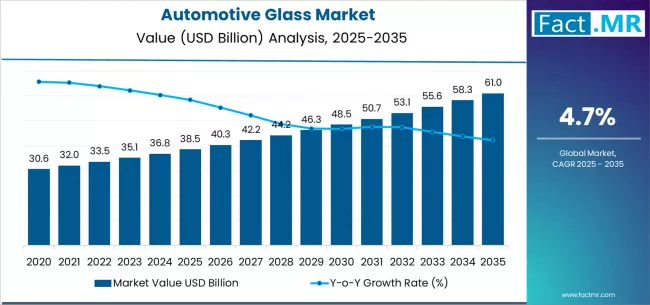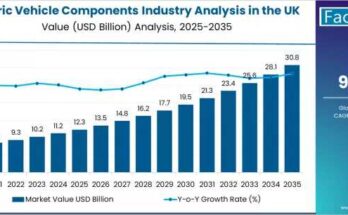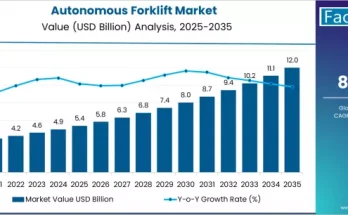Automotive glass has evolved far beyond basic transparency, becoming a critical component of vehicle safety, comfort, and technological integration. Modern automotive glass delivers impact resistance, UV protection, acoustic insulation, and compatibility with advanced driver-assistance systems (ADAS), heads-up displays (HUDs), and connected vehicle technologies. Rising automotive production, demand for enhanced passenger comfort, and integration of smart features in vehicles are driving growth in the automotive glass market.
Market Overview:
The automotive glass market includes products such as tempered glass, laminated glass, and advanced smart glass technologies. Tempered glass dominates due to its safety properties, including controlled breakage patterns, thermal shock resistance, and cost-effectiveness across vehicle applications. Laminated glass offers superior acoustic performance, penetration resistance, and UV protection, making it essential for premium vehicles. Smart and electrochromic glass technologies are increasingly integrated into premium and electric vehicles, offering weight reduction, thermal management, and light control.
Product and Application Insights:
Tempered glass accounts for the largest market share, widely used in side windows, quarter panels, and other applications requiring safety and durability. Laminated glass is critical for windshields, panoramic roofs, and acoustic insulation applications, combining multi-layer construction with soundproofing and safety benefits. Windscreens represent the largest application segment, reflecting both regulatory requirements and consumer demand for integrated HUD and sensor technologies. Other applications include backlites, sidelites, sunroofs, and panoramic roofs, which enhance both aesthetic appeal and cabin comfort.
Vehicle Type Segmentation:
Passenger cars dominate automotive glass consumption due to high production volumes and consumer demand for safety and premium features. Light commercial vehicles and heavy commercial vehicles follow, focusing on durability, cost efficiency, and regulatory compliance. In passenger vehicles, features such as panoramic roofs, acoustic laminated glass, and HUD-compatible windscreens are increasingly adopted to meet evolving consumer expectations.
Regional Insights:
Asia Pacific is the largest regional market, driven by expanding automotive manufacturing in China, India, and other emerging markets. High vehicle production and rising electric vehicle adoption stimulate demand for advanced glazing technologies. North America emphasizes premium glazing features, advanced safety compliance, and innovative technologies. Europe continues to adopt laminated, acoustic, and smart glass solutions, especially in passenger cars and high-end vehicle segments. Emerging markets in Latin America and the Middle East & Africa are witnessing growth as urbanization, rising disposable income, and safety awareness increase.
Market Drivers:
Key factors driving the automotive glass market include:
- Vehicle Safety Regulations:Stringent global safety standards require impact-resistant and laminated glass in passenger vehicles.
- Consumer Demand for Comfort and Aesthetics:Acoustic insulation, panoramic roofs, and UV-protective glass improve cabin experience.
- Growth of Electric Vehicles:Lightweight glazing solutions and advanced glass features are increasingly integrated into EV designs.
- Technological Advancements:HUD-compatible windshields, smart glass, and electrochromic dimming systems enhance vehicle functionality.
- Rising Automotive Production:Expanding manufacturing in Asia Pacific and emerging markets drives demand for both standard and premium automotive glass.
Challenges and Restraints:
Despite growth, challenges include high production costs for laminated and smart glass, complex integration with advanced vehicle systems, and raw material price volatility. Adoption in cost-sensitive markets may be limited by higher prices, while automotive glass manufacturers must ensure quality, durability, and compliance with global standards.
Emerging Trends:
- Smart Glass Integration:Electrochromic and HUD-compatible glass systems are gaining traction in premium vehicles.
- Acoustic and Thermal Management:Multi-layer laminated glass enhances soundproofing and climate control.
- Lightweight and Energy-Efficient Glazing:Reducing vehicle weight while maintaining safety is increasingly prioritized in EVs.
- Panoramic Roof Expansion:Consumers are demanding larger glass roofs for aesthetic and comfort benefits.
- Connected Vehicle Support:Glass integrating antennas and sensors supports telematics and ADAS features.
Competitive Landscape:
Key players in the automotive glass market include AGC Inc., Saint-Gobain, Fuyao Glass Industry Group, Nippon Sheet Glass, and Xinyi Glass Holdings. Companies compete through innovation, comprehensive glazing solutions, and strategic partnerships with OEMs. Emphasis on safety, acoustic performance, optical quality, and smart features differentiates market leaders from traditional glass manufacturers. OEM-focused engineering, modular glazing solutions, and advanced testing ensure compliance with diverse vehicle specifications and regional regulations.
Future Outlook:
The automotive glass market is expected to grow steadily, driven by global vehicle production, adoption of EVs, and demand for enhanced passenger comfort and safety. Tempered glass will remain dominant, while laminated and smart glass technologies gain share in premium segments. Emerging markets will continue to expand, fueled by rising vehicle ownership and demand for advanced safety and comfort features. Technological innovation in glazing solutions, including weight reduction, acoustic performance, and integration with connected vehicle systems, will shape the market’s future trajectory.
Conclusion:
Automotive glass has become an indispensable component of modern vehicles, combining safety, comfort, and technology integration. As manufacturers adopt advanced glazing solutions, consumer demand for aesthetic, acoustic, and smart features continues to rise. With growth driven by both emerging and mature markets, tempered, laminated, and smart glass technologies will collectively define the future of automotive glazing. Companies investing in innovation, quality assurance, and OEM partnerships will lead the market in meeting evolving vehicle design and regulatory requirements.
Browse Full Report – https://www.factmr.com/report/automotive-glass-market



